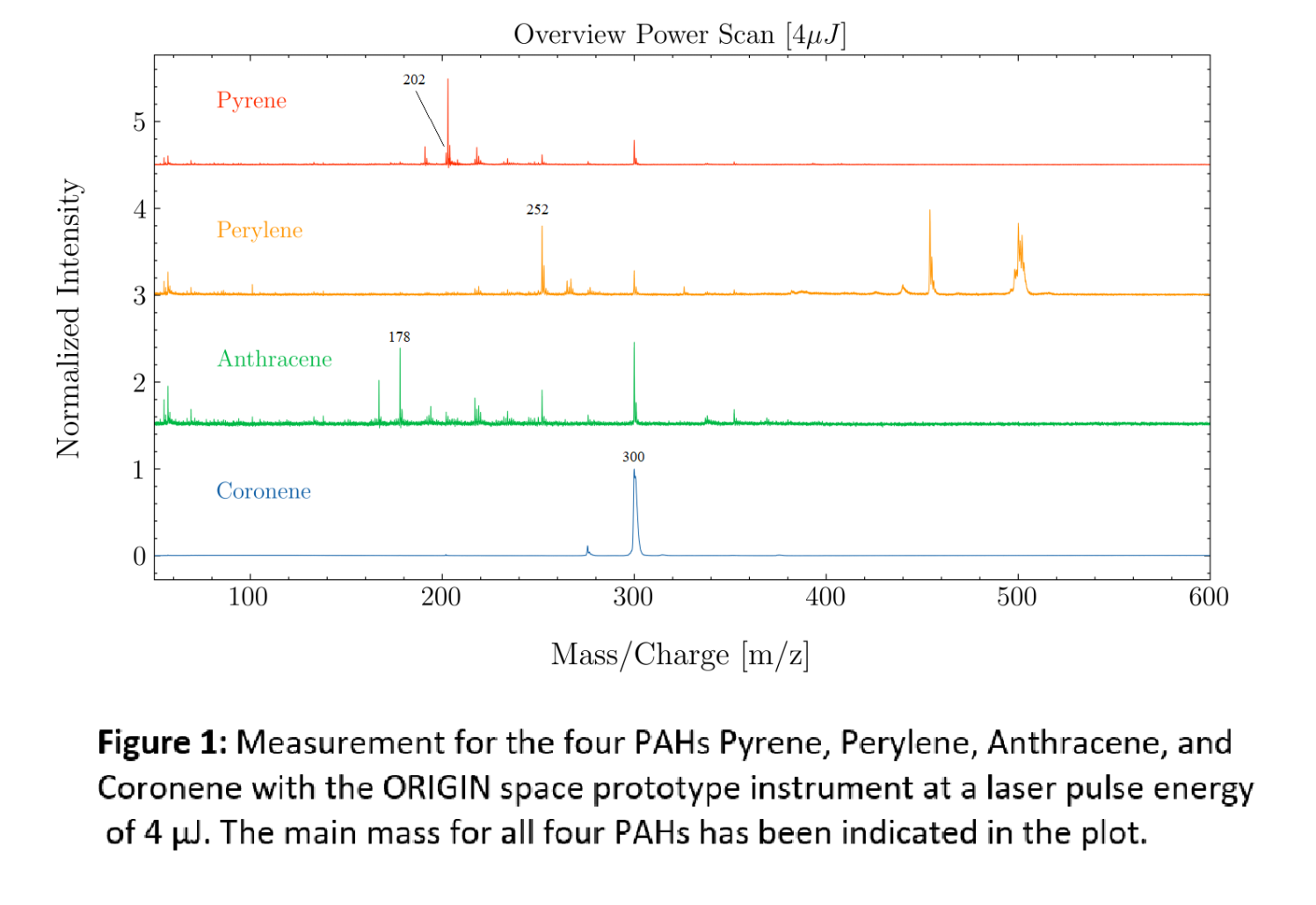Towards detecting carbon chemistry on planetary objects with the ORIGIN space instrument
- 1Space Research and Planetary Sciences, Physics Institute, University of Bern, Bern, Switzerland (kristina.kipfer@space.unibe.ch)
- 2Laboratory for Astrophysics, Leiden Observatory, Leiden University, Leiden, The Netherlands
Polycyclic aromatic hydrocarbons (PAHs) are thought to play an important role as indicators for chemical processes in the interiors and on the surfaces of planets and moons. Based on the strength of the Unidentified Infrared Bands it is estimated that 10 –25% of all carbon in the ISM joins together to form the multi-ringed structure of PAHs [Tielens, 2008]. Therefore, this class of molecules is a ubiquitous and important tracer of chemical processes, which can be investigated with instruments on space exploration missions.
The ORganics Information Gathering INstrument (ORIGIN) is a prototype space instrument developed and built at the University of Bern, Switzerland, for the detection of biomolecules on planetary surfaces [Ligterink et al., 2020] [Riedo et al., 2013]. ORIGIN is Laser Ionization Mass Spectrometer (LIMS) operated at desorption conditions. A single 266 nm nanosecond laser pulse is used to desorb and ionize gently molecules from a steel sample surface, located in a vacuum chamber at a pressure of P<10-7 mbar. The ions are subsequently detected with a miniature reflectron-type time-of-flight mass analyser. The steel sample holder is placed onto an xyz-translation stage, which allows accurate positioning relative to the mass analyser and to analyse samples at multiple positions.
Four different PAHs were investigated in this measurement campaign: Anthracene (C14H10), Coronene (C24H12), Pyrene (C16H10), and Perylene (C20H12), which are representative of PAHs of different structures and sizes. These molecules are analysed at different average surface concentrations (0.1 – 700 picomol mm-2) and laser pulse energies (1-4 µJ).
Figure 1 shows the mass spectra of the four PAHs measured at 4 µJ, demonstrating for the first time ORIGINs' ability to detect these species. The instrument shows the highest sensitivity for Coronene and the lowest for Anthracene. Identifying peaks for Coronene, Perylene and Pyrene can be detected even at a pulse energy of 1 µJ. At a higher laser pulse energy of 3 µJ, surface concentrations as low as 0.14 picomol mm-2 could be detected in the case of Pyrene, indicating that the limit of detection is even lower. Fragmentation of the PAHs is simple and limited, which reduces isobaric interferences of these molecules in complex mixtures and makes their identification easier. Moreover, the observed PAH fragments do not overlap with signatures from amino acids investigated earlier [Ligterink et al., 2020], meaning that if both species are present a reliable identification is possible. Note that at elevated mass/charge ratios of beyond 400 broadened mass peaks are observed. The ion optical setup used for this campaign was optimised for peaks below a mass of 300 and will be improved for upcoming studies.
The result of this measurement campaign shows that ORIGIN can detect PAHs at low surface concentrations and different laser pulse energies. This further shows the capabilities of the instrument in analysing the composition of planetary surfaces, the results of which can be used to characterize the chemical environments.

References:
Tielens, A.G.G.M. Interstellar polycyclic aromatic hydrocarbon molecules. Annual Review of Astronomy and Astrophysics, 46(1):289–337, 2008
Ligterink, N.F.W., Grimaudo, V., Moreno-García, P. et al. ORIGIN: a novel and compact Laser Desorption – Mass Spectrometry system for sensitive in situ detection of amino acids on extraterrestrial surfaces. Sci Rep 10, 9641 (2020).
Riedo, A. Bieler, M. Neuland, M. Tulej, and P. Wurz, Performance evaluation of a miniature laser ablation time-of-flight mass spectrometer designed for in situ investigations in planetary space research, J. Mass Spectrom., 48, 2013, 1 - 15
How to cite: Kipfer, K., Ligterink, N., Schwander, L., de Koning, C., Keresztes Schmidt, P., Grimaudo, V., Lukmanov, R., Tulej, M., Bouwman, J., Riedo, A., and Wurz, P.: Towards detecting carbon chemistry on planetary objects with the ORIGIN space instrument, Europlanet Science Congress 2021, online, 13–24 Sep 2021, EPSC2021-711, https://doi.org/10.5194/epsc2021-711, 2021.

